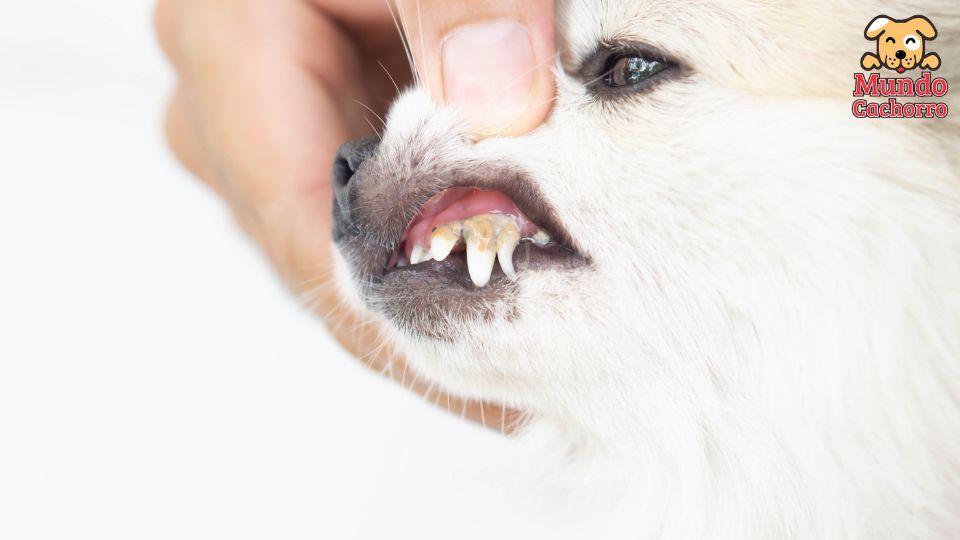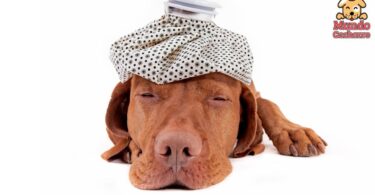Maintaining your dog’s dental health is essential to his overall well-being. Tartar, a buildup of hardened plaque on the teeth, is one of the most common problems that can affect dogs. If left untreated, tartar can lead to periodontal disease, infection and, in severe cases, tooth loss.
Fortunately, there are effective ways to prevent and remove tartar, ensuring your dog maintains a healthy smile and avoiding more serious complications.
In this article, we explain how to remove tartar from your dog’s teeth and how to keep his oral health in top condition. 
Indice
1. What is tartar and why is it dangerous?
Tartar forms when plaque, a sticky film of bacteria, hardens on your dog’s teeth. This occurs when plaque is not removed regularly, which allows minerals in the saliva to deposit and harden the plaque, turning it into tartar.
Unlike plaque, which can be removed with a good brushing, tartar is more difficult to remove and usually requires the intervention of a veterinarian. Tartar not only affects the appearance of your dog’s teeth, but can also have serious health consequences. Bacteria trapped in tartar can cause inflammation of the gums, known as gingivitis, and if left untreated, can progress to periodontitis, a deeper infection that can destroy the tissues that support the teeth.
In addition, bacteria can enter the bloodstream and affect vital organs such as the heart, liver and kidneys.
Signs that your dog has tartar
Some signs that your dog may have a tartar problem include bad breath, red or swollen gums, discoloration of the teeth, and difficulty eating.
If you notice any of these symptoms, it is important to take steps to remove tartar and prevent future problems.
2. Regular brushing: the key to tartar prevention
Regular brushing of your dog’s teeth is the most effective way to prevent tartar buildup. Like humans, dogs need frequent teeth cleaning to remove plaque before it turns into tartar.
Ideally, you should brush your dog’s teeth at least two to three times a week, although daily is best. Use a toothbrush specifically designed for dogs and a special toothpaste for them. Never use human toothpaste, as ingredients such as fluoride can be toxic to dogs.
Brushing should be a gentle and pleasant process for your dog, so make sure he is relaxed and comfortable before you begin.
How to get your dog used to brushing
If your dog is not used to tooth brushing, start gradually. Let him sniff and lick the toothpaste first, then introduce the brush with gentle strokes, focusing on a small area of his mouth.
As he becomes more comfortable, gradually increase the time and number of teeth you brush.
Reward your dog with a treat or praise after each session to create a positive association with brushing.
3. Proper diet and chew toys
Your dog’s diet also plays a crucial role in preventing tartar. Dry foods, such as kibble, can help reduce plaque buildup, as chewing naturally scrapes the teeth.
In contrast, wet food tends to stick to the teeth more and can contribute to tartar formation if not accompanied by a dental hygiene routine. In addition to a proper diet, chew toys and bones can be very effective in keeping your dog’s teeth clean. Toys designed for dental hygiene are made of materials that help scrape plaque off teeth while your dog chews, providing additional cleaning between brushings.
Some toys even come impregnated with agents that help prevent tartar.
Choosing the right toys
When choosing toys for your dog’s dental hygiene, make sure they are safe and suitable for his size and bite strength. Avoid real bones or extremely hard toys that could cause tooth fractures.
Sturdy rubber or nylon toys are usually a good choice, as they are firm enough to clean teeth, but not so hard as to cause damage.
4. Regular visits to the veterinarian
Even with good dental care at home, it is essential that you take your dog to the veterinarian for regular dental checkups. Your veterinarian can evaluate your dog’s oral health, identify any early problems and perform professional cleanings if necessary.
During a professional dental cleaning, the veterinarian will remove tartar and plaque that cannot be removed at home, and thoroughly examine your dog’s teeth and gums. The frequency of these cleanings will depend on your dog’s predisposition to develop tartar, which can vary by breed, age and diet.
Small dogs, in particular, are more prone to dental problems and may need more frequent cleanings than larger breeds.
Preparation for dental cleaning
Prior to the dental cleaning, your veterinarian may recommend a blood test to make sure your dog is healthy enough for anesthesia, as most professional dental cleanings are performed under sedation.
Although it may seem like an intimidating process, regular dental cleanings are an important part of your dog’s overall health care and can prevent serious complications in the future.
5. Home treatments and products for tartar control
There are products on the market that can help control tartar formation on your dog’s teeth. These include water additives, gels and sprays that are applied directly to the teeth.
These products contain enzymes and other agents that help break down plaque and reduce tartar buildup. While these products can be helpful, they should not replace regular brushing and veterinary visits.
They are a good addition to your dog’s dental hygiene routine, especially for those who are more prone to developing tartar or who have pre-existing dental problems.
Using additional products with caution
When using additional tartar control products, follow the manufacturer’s instructions and consult with your veterinarian to make sure they are safe and appropriate for your dog. Some dogs may be sensitive to certain ingredients, so it is important to watch for any adverse reactions and discontinue use if necessary.
Taking care of your dog’s dental health is vital
Your dog’s dental health is a fundamental part of his overall well-being. Preventing and removing tartar is essential to avoid serious problems such as periodontal disease, infections and tooth loss.
With regular brushing, a proper diet, the use of chew toys and regular visits to the veterinarian, you can ensure that your dog’s teeth remain clean and healthy throughout his life.
Don’t underestimate the importance of good dental hygiene, as a dog with healthy teeth is a happier, more energetic dog.







